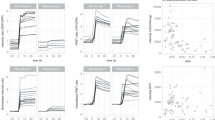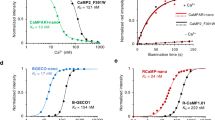Abstract
Important Ca2+ signals in the cytosol and organelles are often extremely localized and hard to measure. To overcome this problem we have constructed new fluorescent indicators for Ca2+ that are genetically encoded without cofactors and are targetable to specific intracellular locations. We have dubbed these fluorescent indicators ‘cameleons’. They consist of tandem fusions of a blue- or cyan-emitting mutant of the green fluorescent protein (GFP)1,2, calmodulin3,4,5, the calmodulin-binding peptide M13 (ref. 6), and an enhanced green- or yellow-emitting GFP7,8,9. Binding of Ca2+ makes calmodulin wrap around the M13 domain, increasing the fluorescence resonance energy transfer (FRET) between the flanking GFPs2. Calmodulin mutations can tune the Ca2+ affinities to measure free Ca2+ concentrations in the range 10−8 to 10−2 M. We have visualized free Ca2+ dynamics in the cytosol, nucleus and endoplasmic reticulum of single HeLa cells transfected with complementary DNAs encoding chimaeras bearing appropriate localization signals. Ca2+ concentration in the endoplasmic reticulum of individual cells ranged from 60 to 400 µM at rest, and 1 to 50 µM after Ca2+ mobilization. FRET is also an indicator of the reversible intermolecular association of cyan-GFP-labelled calmodulin with yellow-GFP-labelled M13. Thus FRET between GFP mutants can monitor localized Ca2+ signals and protein heterodimerization in individual live cells.
This is a preview of subscription content, access via your institution
Access options
Subscribe to this journal
Receive 51 print issues and online access
$199.00 per year
only $3.90 per issue
Buy this article
- Purchase on SpringerLink
- Instant access to full article PDF
Prices may be subject to local taxes which are calculated during checkout




Similar content being viewed by others
References
Heim, R., Prasher, D. C. & Tsien, R. Y. Wavelength mutations and post-translational autooxidation of green fluorescent protein. Proc. Natl Acad. Sci. USA 91, 12501–12504 (1994).
Heim, R. & Tsien, R. Y. Engineering green fluorescent protein for improved brightness, longer wavelengths and fluorescence energy transfer. Curr. Biol. 6, 178–182 (1996).
Crivici, A. & Ikura, M. Molecular and structural basis of target recognition by calmodulin. Annu. Rev. Biophys. Biomol. Struct. 24, 85–116 (1995).
Babu, Y. S., Bugg, C. E. & Cook, W. J. Structure of calmodulin refined at 2.2 Å resolution. J. Mol. Biol. 204, 191–204 (1988).
Falke, J. J., Drake, S. K., Hazard, A. L. & Peersen, O. B. Molecular tuning of ion binding to calcium signaling proteins. Q. Rev. Biophys. 27, 219–290 (1994).
Ikura, M.et al. Solution structure of a calmodulin-target peptide complex by multidimensional NMR. Science 256, 632–638 (1992).
Heim, R., Cubitt, A. B. & Tsien, R. Y. Improved green fluorescence. Nature 373, 663–664 (1995).
Cormack, B. P., Valdivia, R. H. & Falkow, S. FACS-optimized mutants of the green fluorescent protein (GFP). Gene 173, 33–38 (1996).
Ormö, M.et al. Crystal structure of the Aequorea victoria green fluorescent protein. Science 273, 1392–1395 (1996).
Grynkiewicz, G., Poenie, . & Tsien, R. Y. Anew generation of Ca2+ indicators with greatly improved fluorescence properties. J. Biol. Chem. 260, 3440–3450 (1985).
Tse, F. W., Tse, A. & Hille, B. Cyclic Ca2+ changes in intracellular stores of gonadotropes during gonadotropin-releasing hormone-stimulated Ca2+ oscillations. Proc. Natl Acad. Sci. USA 91, 9750–9754 (1994).
Hofer, A. M. & Schulz, I. Quantification of intraluminal free [Ca] in the agonist-sensitive internal calcium store using compartmentalized fluorescent indicators: some considerations. Cell Calcium 20, 235–242 (1996).
Golovina, V. A. & Blaustein, M. P. Spatially and functionally distinct Ca2+ stores in sarcoplasmic and endoplasmic reticulum. Science 275, 1643–1648 (1997).
Montero, M.et al. Monitoring dynamic changes in free Ca2+ concentration in the endoplasmic reticulum of intact cells. EMBO J. 14, 5467–5475 (1995).
Kendall, J. M., Badminton, M. N., Sala-Newby, G. B., Campbell, A. K. & Rembold, C. M. Recombinant apoaequorin acting as a pseudo-luciferase reports micromolar changes in the endoplasmic reticulum free Ca2+ of intact cells. Biochem. J. 318, 383–387 (1996).
Porumb, T., Yau, P., Harvey, T. S. & Ikura, M. Acalmodulin-target peptide hybrid molecule with unique calcium-binding properties. Protein Eng. 7, 109–115 (1994).
Maune, J. F., Klee, C. B. & Beckingham, K. Ca2+ binding and conformational change in two series of point mutations to the individual Ca2+-binding sites of calmodulin. J. Biol. Chem. 267, 5286–5296 (1992).
Gao, Z. H.et al. Activation of four enzymes by two series of calmodulin mutants with point mutations in individual Ca2+ binding sites. J. Biol. Chem. 268, 20096–20104 (1993).
Martin, S. R.et al. Spectroscopic characterization of a high-affinity calmodulin-target peptide hybrid molecule. Biochemistry 35, 3508–3517 (1996).
Zolotukhin, S., Potter, M., Hauswirth, W., Guy, J. & Muzyczka, N. A“humanized” green fluorescent protein cDNA adapted for high levels of expression in mammalian cells. J. Virol. 70, 4646–4654 (1996).
Smit, M. J.et al. Extracellular ATP elevates cytoplasmatic free Ca2+ in HeLa cells by the interaction with a 5′-nucleotide receptor. Eur. J. Pharmacol. 247, 223–226 (1993).
Bootman, M. D., Cheek, T. R., Moreton, R. B., Bennett, D. L. & Berridge, M. J. Smoothly graded Ca2+ release from inositol 1,4,5-trisphosphate-sensitive Ca2+ stores. J. Biol. Chem. 269, 24783–24791 (1994).
Brini, M., Marsault, R., Bastianutto, C., Pozzan, T. & Rizzuto, R. Nuclear targeting of aequorin. A new approach for measuring nuclear Ca2+ concentration in intact cells. Cell Calcium 16, 259–268 (1994).
Kendall, J. M., Dormer, R. L. & Campbell, A. K. Targeting aequorin to the endoplasmic reticulum of living cells. Biochem. Biophys. Res. Commun. 189, 1008–1016 (1992).
Bygrave, F. L. & Benedetti, A. What is the concentration of calcium ions in the endoplasmic reticulum? Cell Calcium 19, 547–551 (1996).
Button, D. & Eidsath, A. Aequorin targeted to the endoplasmic reticulum reveals heterogeneity in luminal Ca++ concentration and reports agonist- or InsP3-induced release of Ca++. Mol. Biol. Cell 7, 419–434 (1996).
Romoser, V. A., Hinkle, P. M. & Persechini, A. Detection in living cells of Ca2+-dependent changes in the fluorescence emission of an indicator composed of two green fluorescent protein variants linked by a calmodulin-binding sequence. J. Biol. Chem. 272, 13270–13274 (1997).
Kozak, M. The scanning model for translation: an update. J. Cell Biol. 108, 229–241 (1989).
Adams, S. R., Bacskai, B. J., Taylor, S. S. & Tsien, R. Y. Fluorescent Probes for Biological Activity of Living Cells–A Practical Guide(ed. Mason, W. T.) 133–149 (Academic, New York, (1993)).
Balch, W. E., McCaffery, J. M., Plutner, H. & Farquhar, M. G. Vesicular stomatitis virus glycoprotein is sorted and concentrated during export from the endoplasmic reticulum. Cell 75, 841–852 (1994).
Acknowledgements
We thank S. R. Adams and A. B. Cubitt for advice, C. Zuker for the GFP antibody, and C. Klee for the original Xenopus calmodulin gene. This work was supported by HHMI (R.Y.T.), NIH (R.Y.T.), HFSP (R.Y.T. and A.M.), MRCC (M.I.) and the Spanish Ministry of Science (J.L.). M.I. is an HHMI international research scholar and MRCC scholar.
Author information
Authors and Affiliations
Rights and permissions
About this article
Cite this article
Miyawaki, A., Llopis, J., Heim, R. et al. Fluorescent indicators for Ca2+based on green fluorescent proteins and calmodulin. Nature 388, 882–887 (1997). https://doi.org/10.1038/42264
Received:
Accepted:
Issue Date:
DOI: https://doi.org/10.1038/42264
This article is cited by
-
Highly selective and sensitive recognition of multi-ions in aqueous solution based on polymer-grafted nanoparticle as visual colorimetric sensor
Scientific Reports (2024)
-
Astroglial calcium signaling and homeostasis in tuberous sclerosis complex
Acta Neuropathologica (2024)
-
Sleep restoration by optogenetic targeting of GABAergic neurons reprograms microglia and ameliorates pathological phenotypes in an Alzheimer’s disease model
Molecular Neurodegeneration (2023)
-
Neuronal growth on high-aspect-ratio diamond nanopillar arrays for biosensing applications
Scientific Reports (2023)
-
Fluorescent sensors for imaging of interstitial calcium
Nature Communications (2023)



